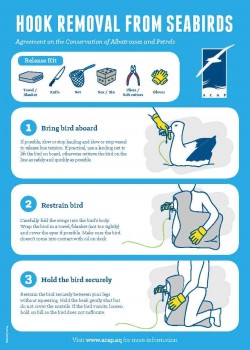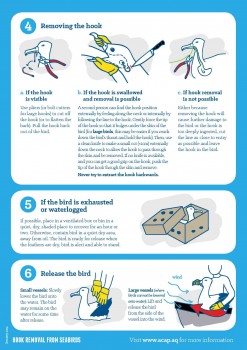ACAP's Seabird Bycatch Working Group heard at its sixth meeting yesterday in Uruguay that Australia has published its updated Threat Abatement Plan for the incidental catch (or bycatch) of seabirds during oceanic longline fishing operations, replacing an earlier version produced in 2006.
The plan has been developed by the Department of the Environment to continue to implement existing as well as new actions needed to abate the listed key threatening process of incidental catch of seabirds during oceanic longline fishing operations. The plan identifies the research, management and other actions needed to reduce the impacts of longlining on affected seabird species, including ACAP-listed albatrosses and petrels.
Mitigation measures required south of 25°S for pelagic tuna longliners include line weighting, use of at least one bird-scaring line and not discharging offal during line setting. Information is also given on minimum levels of observer coverage required in Australian longline fisheries.
The plan’s summary follows:
“Oceanic longlining is a fishing method used to target pelagic and demersal finfish and shark species. This method involves setting one or more single mainlines containing many individual hooks on branch lines or snoods. The mainline can either be anchored or drifting. It can be oriented vertically or horizontally in the water column and vary considerably in length and number of hooks. Longlining occurs in almost all Australian waters.
The adverse impact of longline fishing activities on seabirds was not fully realised until the 1980s. The incidental catch (or bycatch) of seabirds during oceanic longline fishing operations was listed as a key threatening process on 24 July 1995.
Threat abatement plans for this key threatening process have been in place since 1998 with the current plan, Threat Abatement Plan 2014 for the incidental catch (or bycatch) of seabirds during longline fishing operations, made on 14 August 2014. The ultimate aim of this plan is to achieve zero bycatch of seabirds from longline fishing in Commonwealth fisheries.
Considerable progress has been made under successive threat abatement plans to reduce the impact of oceanic longlining on seabirds. This has been achieved through the combined efforts of the fishing industry, researchers and non-governmental stakeholders working with government to reduce seabird bycatch in longline fisheries in a feasible, effective and efficient way. The prescriptions in this plan recognise this success and seek to further reduce the incidental capture of seabirds.
Threat abatement plans provide a national strategy to guide the activities of government, industry and research organisations in abating the impact of key threatening processes. The content of a plan must provide for the research, management and other actions necessary to reduce the key threatening process to an acceptable level. Content requirements and matters to be taken into consideration are outlined in s 271 of the Environment Protection and Biodiversity Protection Act 1999. Accordingly, this plan, among other things, states the objective to be achieved; specifies the actions to achieve the objective; states the criteria to measure performance of the plan; identifies the organisations and persons involved in evaluating the performance of the plan; and identifies albatross and other seabird species affected by the key threatening process. The plan is subject to review within five years.”

Shy Albatross on Albatross Island: endemic to Australia. Photograph by Drew Lee
The SBWG will wrap up its three-day meeting today. Next week the ACAP Advisory Committee will consider its report, along with that of the Population and Conservation Status Working Group.
Reference:
Commonwealth of Australia 2014. Threat Abatement Plan 2014 for the Incidental Catch (or Bycatch) of Seabirds during Longline Fishing Operations. Canberra: Department of the Environment. 34 pp.
John Cooper, ACAP Information Officer, 14 September 2014


 English
English  Français
Français  Español
Español 



